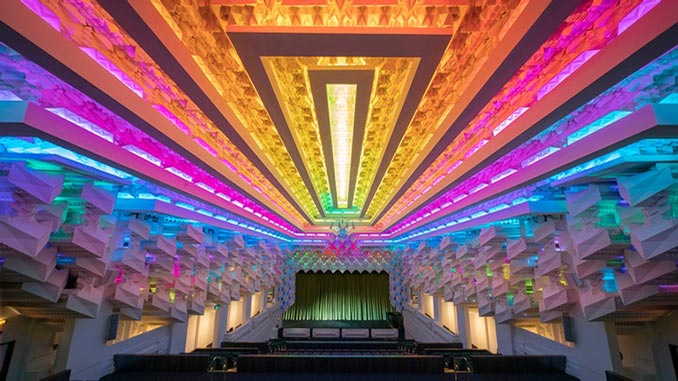 From silent films to near-demolition, refurbishments and reinvention, the theatre has stood the test of time to remain a cultural icon of Melbourne.
From silent films to near-demolition, refurbishments and reinvention, the theatre has stood the test of time to remain a cultural icon of Melbourne.
Built in 1924 by renowned architects Marion Mahony Griffin and Walter Burley Griffin, the Chicago-Gothic-style theatre is regarded their greatest interior design work.
The Capitol was the first extravagant “picture palace” to be built in Victoria, seating over 2,100 people in sweeping stalls and circles.
The Capitol’s doors opened in November 1924 during the silent film era, with its first screening the original religious film epic The Ten Commandments, produced and directed by Cecil B De Mille.
The theatre is perhaps best known for its iconic ceiling, made up of 33,000 plaster crystals illuminated by thousands of coloured lights to create the impression of a crystalline cave.
Adding to the theatre of the movie-going experience, the red, yellow, blue and green light displays were often choreographed to play in time with live orchestral scores.
Moving with the times
Over the decades the theatre has adapted with the times. With cinema audiences dwindling in the 1950s with the advent of television, The Capitol was saved from demolition following a campaign spearheaded by prominent architect Robin Boyd.
A compromise saw the street foyer and stalls demolished to make way for a shopping arcade, now known as the Capitol Arcade, while the ceiling and upper half of the auditorium was retained to create a single-level cinema seating 600 people.
In 1999, RMIT acquired the building to preserve its heritage and use it for teaching and learning and public programming activities. After falling into critical disrepair, The Capitol was closed and an appeal launched to restore it to its former glory.
The Capitol reopened its doors in 2019 following a multi-million-dollar refurbishment, reclaiming its place as a Melbourne cultural icon.
 The Capitol reimagined
The Capitol reimagined
Vice-Chancellor and President Professor Alec Cameron said RMIT was proud to restore and reopen The Capitol – now a place of transformative learning, teaching, research and mentoring for a new generation and those to come.
“More than a theatre, The Capitol of today is testament to RMIT’s determination to respect the past even as we prepare our students for an ever-changing future,” he said.
“The outcome remains a spectacular Melbourne icon, filled with RMIT’s innovative spirit. It is a hub of creativity and collaboration, bringing together our students – past and present – with the wider community, including the creative industries of Melbourne and beyond.”
“We are proud to be custodians of such an important landmark and pay tribute to 100 years of history – with eyes firmly on the 100 ahead.”
Restoring Eliza – the Wurlitzer organ
An integral piece of The Capitol was its Wurlitzer Organ, the first of its kind in Australia when the theatre first opened.
Affectionally known as Eliza, the Organ replicates a full orchestra and a full range of sound effects. In the silent film era, she was as integral to the cinema experience as the action on screen.
After being removed in 1967 and relocated to the Dendy Cinema in Brighton, part of Eliza was returned to The Capitol in 2021.
Cameron said reinstalling the rest of this magnificent machine would not only preserve an important part of Melbourne’s cultural history, but create new opportunities for today’s students, musicians, filmmakers and audiences.
“RMIT is proud to launch a fundraising campaign dedicated to returning Eliza to her former glory and rightful home,” he said. “Donations, large or small, will be part of a new chapter for this magnificent instrument.”
For more information about The Capitol’s centenary and the Eliza appeal, visit: www.rmit.edu.au for details. Take a look at this short video.
Celebrating 100 years of architectural and cinematic wonder at The Capitol
Story by Mary Gillman and Thomas Odell
This article is republished with kind permission from RMIT News. Read the original article.
Images: The Capitol – courtesy of RMIT | The interior of The Capitol – photo by John Gollings
